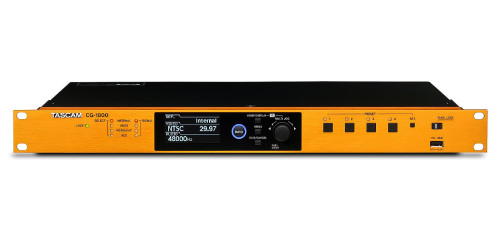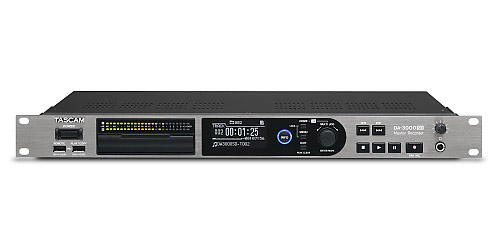CG-2000
Master Clock Generator
The CG-2000 master clock generator is based on a high-precision crystal oscillator with jitter management and glitch-free relocking for ultra-high clock precision. It is designed for the needs of broadcasting and post production, large-scale video/audio synchronization systems, recording studios, live sound applications and professional musicians.
The crystal oscillator is the heart of the clock generator. An OCXO (oven-controlled crystal oscillator) is used for its high precision, and the fact it is not influenced by the temperature of the environment. Boasting a clock frequency precision of 0.01 ppm*1, which exceeds that of a TCXO (temperature-compensated crystal oscillator), these units are key in the creation of high-precision synchronization systems with word output frequency stability of ±0.005 ppm or less per day. Each model is equipped with an input connector that supports a 10-MHz signal. This allows it to be connected to a rubidium clock or GPS clock for even higher precision.
External clock jitter is reduced using an original Tascam circuit design that incorporates a high-performance video clock generator engineered with a FPGA*2 and a PLL (phase-locked loop) circuit with a discrete filter. This enables a stable clock signal to be provided to the video/word outputs for improved system stability. The glitch-free relock circuit prevents noise and skipping sounds caused by master clock dropouts.
In addition to twelve word clock outputs and four video outputs, the digital outputs include two AES3/AES11 and two S/PDIF outputs, making the units useful for large-scale audio/video synchronization systems, and a wide variety of other applications. Of the twelve word outputs, two also support x2Fs, x4Fs and 256Fs output for use in systems with ProTools and other DAW software.
The CG-2000 has multiple functions to support maintenance, and the identification of issues if problems occur. The analyzer function measures output device termination, input level measurement, and the measurement of input frequencies. These built-in features enable the devices to provide troubleshooting support. Additionally, a logging function allows issues to be listed, and saved to a CSV file format on a USB flash drive. Since crystal oscillators change over time, regular calibration is necessary. In order to avoid possible sync problems, timely inspections along with regular maintenance is required. For this purpose, the CG-2000 has a self-calibration function, enabling users to conduct maintenance using an external input signal*3 and simple operations.
Amphenol BNC connectors on the chassis use nuts for coupling, making them very durable. Also, a single circuit board is used for each connector providing excellent resistance to the twisting and pulling of cables, and the suppression of interference between connectors.
The CG-2000 is the latest in the line of innovative Tascam professional digital products – engineered with the latest digital clocking technology.
*1 Factory default value
*2 FPGA (Field Programmable Gate Array)
*3 Use of the self-calibration function requires preparation of a separate PPS-output 10MHz oscillator with a built-in GPS antenna.
Features at a glance
- The ultimate solution for broadcast and postproduction studios
- Highest reliability through redundant power supply and redundant video sync and wordclock inputs
- Stable synchronization between picture and sound
- Flexible system setup with a large variety of audio and video formats (Audio: Wordclock, AUS3, AES11, SPDIF, Video: NTSC, PAL, HD tri-level)
- High-quality OCXO (Oven Controlled Crystal Oscillator) oscillator for highly accurate clock signal generation
- Jitter management circuit and glitch-less relock management to avoid problems caused by master clock signal
- Clock input supports clock rates up to 10 MHz
- 4 video sync outputs, 12 wordclock outputs, 2 AES3 or AES11 outputs, 2 SPDIF outputs
- 2 wordclock outputs support Fs/4, Fs/2, 2 Fs, 4 Fs and 256 Fs to be used with ProTools and other DAW software
- Support for 0.1%, 4 % pull-up/pull-down
- Self-calibration function* allows maintenance by operator for optimum accuracy at any time
- Output levels of the wordclock connectors can be adjusted
- GPO signaling outputs for monitoring the error status
- Analyzer feature allows to measure input frequencies, input levels and the termination of output devices
- Logging function for troubleshooting (check the log on the display or capture a CSV-format file on a USB flash drive)
- Up to 4 system settings can be saved for recall and saved settings can be imported and exported via USB
- Panel-lock to prevent misoperation
- Organic EL display with a wide viewing angle
- Firmware updates possible using the USB port
*Use of the self-calibration function requires preparation of a separate PPS-output or 10-MHz oscillator with a built-in GPS antenna
Specifications
| Inputs and outputs | |
|---|---|
| VIDEO INPUT | BNC connector |
| Input level | 0.5–2.0 Vp-p |
| Input impedance | 75 Ω (can turn ON/OFF in menu) |
| Input format | SD video black burst: NTSC (RS-170A), PAL (ITU-R624) SD video composite sync: NTSC B/W (RS-170) HD video tri-level: 720p/50/59.94/60 (SMPTE 296M) 1080p/23.976/24/25/29.97/30/50/59.94/60 (SMPTE 274M) 1080i/23.976/24/25/29.97/30 (SMPTE 274M) 1080PsF/23.976/24/25/29.97/30 (SMPTE RP211) |
| Permitted frequency deviation | ±10 ppm |
| WORD/EXT INPUTS | BNC connector |
| Input level | 0.5–5.0 Vp-p |
| Input impedance | 75/50 Ω (can set to 75/50/OFF in menu) |
| Supported frequencies | WORD CLOCK: 32/44.1/48/88.2/96/176.4/192 kHz (−4/−0.1/0.0/+0.1/+4% PULL UP/DOWN supported only when 48/96/192 kHz selected) ATOM: 10.0 MHz GPS: 10.0 MHz |
| Permitted frequency deviation | ±10 ppm |
| AES3/11 INPUT | XLR-3-31 (1: GND, 2: HOT, 3: COLD) |
| Input level | 0.2–10 Vp-p |
| Input impedance | 110 Ω |
| Format | AES11-2003, AES3-2003, IEC60958-4 |
| Supported frequencies | 32/44.1/48/88.2/96/176.4/192 kHz (−4/−0.1/0.0/+0.1/+4% PULL UP/DOWN supported only when 48/96/192 kHz selected) |
| Permitted frequency deviation | ±10 ppm |
| CALIBRATION INPUT | BNC connector |
| Input level | 0.5–5.0 Vp-p |
| Input impedance | 50 Ω (can turn ON/OFF in menu) |
| Supported frequencies | ATOM: 10.0 MHz GPS: 10.0 MHz, PPS |
| VIDEO OUTPUTS | BNC connector |
| Output impedance | 75 Ω |
| Output format | SD video black burst: NTSC (RS-170A), PAL (ITU-R624) SD video composite sync: NTSC B/W (RS-170) HD video tri-level: 720p/50/59.94/60 (SMPTE 296M) 1080p/23.976/24/25/29.97/30/50/59.94/60 (SMPTE 274M) 1080i/23.976/24/25/29.97/30 (SMPTE 274M) 1080PsF/23.976/24/25/29.97/30 (SMPTE RP211) |
| WORD OUTPUTS | BNC connector |
| Output level | 1.0–3.5Vp-p (can set by 0.5V steps in menu) |
| Output impedance | 75 Ω |
| Supported frequencies | 32/44.1/48/88.2/96/176.4/192 kHz 11.2896/12.288 MHz (Super Clock, only connectors 11/12) (−4/−0.1/0.0/+0.1/+4% PULL UP/DOWN supported only when 48/96/192 kHz selected) |
| AES3/11 OUTPUTS | XLR-3-32 (1: GND, 2: HOT, 3: COLD) |
| Output level | 2.5 Vp-p |
| Output impedance | 110 Ω |
| Format | AES11-2003, AES3-2003, IEC60958-4 |
| Supported frequencies | 32/44.1/48/88.2/96/176.4/192 kHz |
| S/PDIF OUTPUTS | RCA pin jack |
| Output level | 0.5 Vpp |
| Output impedance | 75 Ω |
| Format | IEC 60958-3 (SPDIF) |
| Supported frequencies | 32/44.1/48/88.2/96/176.4/192 kHz (−4/−0.1/0.0/+0.1/+4% PULL UP/DOWN supported only when 48/96/192 kHz selected) |
| ALARM OUTPUT (CG-2000 only) | 6-pin Euroblock connector |
| Output format | Open collector |
| Output impedance | 10 Ω |
| Dielectric strength | 20 V |
| Maximum output current | 50 mA |
| Performance | |
|---|---|
| Internal oscillator | OCXO (oven-controlled crystal oscillator) |
| Permitted frequency deviation | ±0.01 ppm (Adjusted value when shipped new from the factory) |
| Frequency temperature characteristics | ±0.05 ppm (0 to 40 ºC) |
| Long-term frequency stability | ±0.005 ppm (daily) ±0.5 ppm (annually) |
| Power supply and other specifications | |
|---|---|
| Power | 100–240 V |
| Power consumption | 14 W |
| External dimensions (w × h × d) | 483 mm × 44 mm × 310mm |
| Weight | 3.3 kg |
| Operating temperature range | 0–40 °C |
Design and specifications subject to change without notice.
Page last modified: 2025-11-11 11:40:03 UTC






